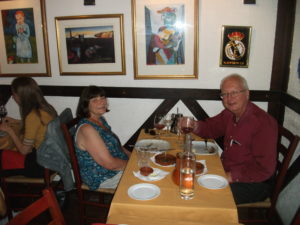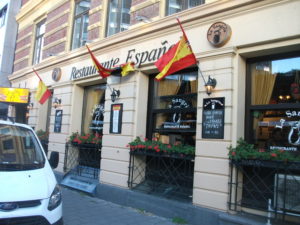It has been almost a month since my last blog post, for a reason. I spent most of the remainder of July at a conference in Colorado, for four days, and then overseas, for nearly two weeks. My wife and I traveled to Norway for a vacation, and I chose to separate myself from my laptop for the duration. In coming weeks, I will produce some travelogue posts about that trip, as I have often done in the past. Norway has a great deal to offer for curious travelers.
But first, I want to describe some issues from an experience I am sure many other travelers have shared. Some aspects of this experience, I am sure, are an inevitable part of travel, which always involves the possibility of delays, whether from weather, traffic accidents, or equipment malfunctions, on highways, in the air, or on water. Other aspects are a function of corporate culture and the way in which airlines or other transportation providers choose to communicate with and respond to their customers.
Our flight from Chicago on July 15 began with United Airlines, on which I had used award miles to book both of us to Frankfurt, Germany, with connection on Lufthansa (a Star Alliance partner of United) to Oslo. United Airlines suffered earlier this year from a tsunami of negative publicity for its ill-considered removal of Dr. David Dao from a flight to Louisville, Kentucky, from O’Hare International Airport. The brutal dragging of this paying customer from his seat to make room for airline staff also besmirched the reputation of the Chicago Department of Aviation’s airport police, whose desire to become armed police suffered a long-term setback because of the incident. Followed by some inadequate corporate explanations before CEO Oscar Munoz finally issued a full apology, the incident made no one look good.
I mention this only because, in my opinion, the situation that evolved on our trip shows that United Airlines still has considerable room to improve in learning how to inform and serve its customers when problems arise. Our flight was scheduled to depart at 2:35 p.m., arriving at Frankfurt at 5:55 a.m., with a 7:05 a.m. connecting flight to Oslo. About one hour before that, I began to notice that no one was arriving to staff the original gate assignment, and the number of people present seemed modest for an international flight. Naturally suspicious, I rechecked the monitor in the hallway to discover that the flight had been moved to another gate. That happens, but I did politely ask at the new gate why I had not gotten a text from United, which routinely happens with all updates.
“You always have to check on gate assignments,” she said. I was aware of that—I have traveled a great deal over the years—but she did not really answer the question of why a routine update had not occurred via text. Instead, I got a reply that implied that I did not know any better. Thanks for the condescension, United.
It went downhill from there, as the United personnel learned that something was apparently awry with the engine on the aircraft and needed inspection. What followed was a slow drip of information that materialized in eight separate text messages that ultimately resulted in a departure at 5:30 p.m. In the absence of more definitive information in place of the assortment of 15- and 30-minute delay announcements, it was impossible to know at what point one’s connections would become impossible or, for that matter, which subsequent rebooked connection would be viable. Predictably, the lines for rebooking at both the gate and the United service center became long. At one point, one of the gate attendants checked on later flights and told me, “I’ve backed you up for 10:00.” What I learned later was that the phrase “backed up,” which I’d never heard before, effectively meant nothing. A new boarding pass in Frankfurt might have been useful. In the confusion and amid the crowd of frustrated passengers, getting better answers proved challenging, to put it mildly. Suddenly, in the end, before any of us knew what connections we would have in Frankfurt, airline personnel announced that boarding would commence. We were in the unenviable position of waiting until we got to Frankfurt to find out how we would get to Oslo. The only advice in Chicago was to go to the Lufthansa desk in Frankfurt (a huge airport) to find out. Our flight finally arrived in Frankfurt around 8:30, as best I recall. By then, I was more interested in facilitating the next leg of our journey than in recording the precise time.
Aboard the plane, those needing to rebook connections were told which gate to go to, but as we deplaned, a woman with a sign was telling the same passengers a slightly different gate. Where to go? Many of us ended up at the gate we were told as we got off, only to find that the Lufthansa attendants seemed even more preoccupied with serving passengers from a flight from Washington, D.C. One challenge in these situations is knowing precisely which line will best expedite your request without being able to just cut to the front to find out. When we did reach the desk, an attendant printed out something other than a boarding pass—I have by now tossed it and can’t remember what useless information it contained—and directed us down the hall to the “gate with the yellow signs.” I soon wondered if she was just getting rid of us because “down the hall” meant nothing. Every Lufthansa desk has yellow logos because that is their corporate color. We began to ask again, but we learned that the 10:00 a.m. flight that had been promised was at A52, which we could reach after going through Passport Control, which went quickly enough. But at A52, we were informed by a somewhat sympathetic Lufthansa agent that the flight in question already had a “wait list” of 30 people. So much for being “backed up” on the 10:00 a.m. flight. Soon, she made clear that she simply could not get both of us on the flight, and we made clear we did not want to fly separately, which would only mean Jean would wait in Oslo for my arrival, adding confusion to an already difficult journey.
When we made clear we would stay together, she directed us to A12 for rebooking. That became another interesting feature of communication involving signage. We reached a hall where signs to the right indicated A11 and below, while Gates 13 and above were to the left. Where was A12? We asked one middle-aged airport employee, who sounded like an American, about the gate and he pointed us to the left. Wrong—when we did not see it and asked at a gate, we were pointed back just behind where he had been. In fact, there was no sign for A12, but it was the Lufthansa service desk, not an actual gate. Why not tell us that to begin with? In any case, one friendly worker there tried to get us new boarding passes from one of the kiosks, but that did not work. We had to take a number (A3108) and wait for the electronic sign to tell us which of five desks would handle our problem. Fortunately, about ten minutes later, we were directed to a lady at the end of the wall. After shaking her head at one point, asking me at another if we had been booked with award miles, and discussing the matter by telephone in German with someone, she finally said, “You’re lucky. These are the last two seats on the 1:15 flight.” I thanked her; she had at least accomplished something for us. As for being lucky, I had mixed feelings. After so much non-direction and misdirection, and some other Lufthansa personnel adding to our growing feeling that customer service was not a high priority, I was no longer sure what “lucky” meant. But at least we knew when we would connect to Oslo.

 Exhausted by then, Jean took a short hike down the hall from our new gate while I watched our belongings. We were getting hungry, so she bought hot dogs for both of us. That may have helped revive us a bit. We reached Oslo at about 3:10 p.m., got our luggage by 4 p.m., and caught a shuttle to the downtown Radisson Blu Hotel, and checked in by 5 p.m. We had lost an entire Sunday afternoon of sight-seeing that we may otherwise have enjoyed. Once we had stored everything in our room, we crossed the street to a Spanish restaurant, our only activity for the evening, and enjoyed tapas and Sangria and chatted with the waiter. Upon discovering that the trip was in part a celebration of my retirement, he arranged for a complimentary dessert of delicious flan with caramel sauce.
Exhausted by then, Jean took a short hike down the hall from our new gate while I watched our belongings. We were getting hungry, so she bought hot dogs for both of us. That may have helped revive us a bit. We reached Oslo at about 3:10 p.m., got our luggage by 4 p.m., and caught a shuttle to the downtown Radisson Blu Hotel, and checked in by 5 p.m. We had lost an entire Sunday afternoon of sight-seeing that we may otherwise have enjoyed. Once we had stored everything in our room, we crossed the street to a Spanish restaurant, our only activity for the evening, and enjoyed tapas and Sangria and chatted with the waiter. Upon discovering that the trip was in part a celebration of my retirement, he arranged for a complimentary dessert of delicious flan with caramel sauce.
At least someone still knows what good customer service still looks like. The place is called La Sangria Restaurante Espanol. If you’re ever in Oslo, pay them a visit and tell them I sent you.
Jim Schwab
Trackbacks/Pingbacks